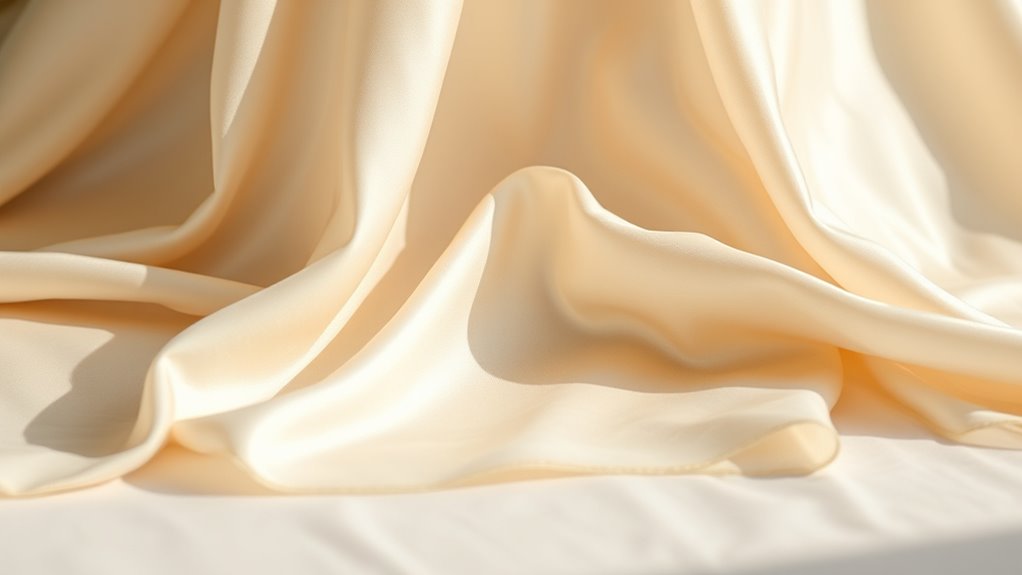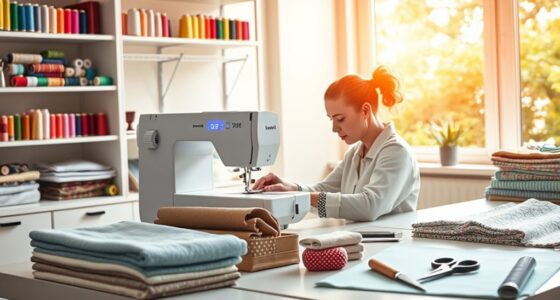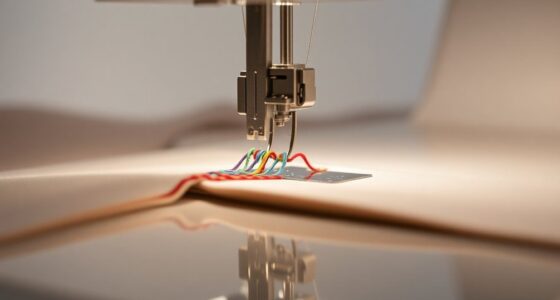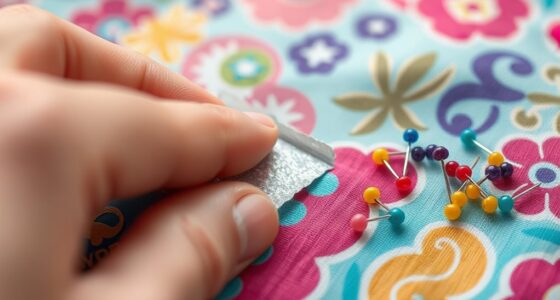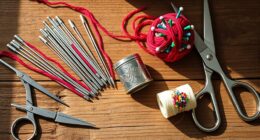To prevent puckering on lightweight fabrics every time, make certain you’re using the right seam stabilizers and proper needle size, like 60/8 or 70/10. Adjust your presser foot pressure and maintain consistent stitch tension, testing on scrap fabric first. Handle your fabric gently, sewing slowly and smoothly, especially around curves. Using pins or clips helps keep layers aligned. If you follow these tips closely, you’ll keep your seams neat and professional—plus, there’s more to learn to perfect your technique.
Key Takeaways
- Use appropriate seam stabilizers like wash-away or tear-away to support lightweight fabrics during sewing.
- Adjust needle size to sharp, fine needles (70/10 or 60/8) to prevent snags and puckering.
- Maintain consistent, slow sewing speed, especially around curves or intricate areas.
- Handle lightweight fabrics gently, avoiding pulling or stretching while guiding through the machine.
- Ensure proper stitch tension by testing on scrap fabric and adjusting gradually for even stitches.
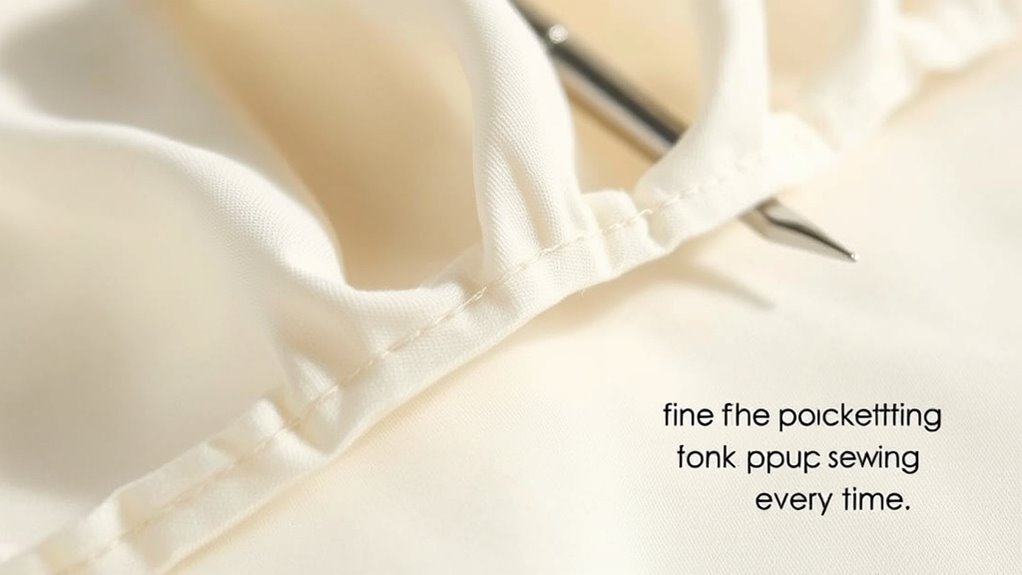
Lightweight fabrics can add elegance to any project, but they’re also prone to puckering if not handled carefully. To keep your seams smooth and professional-looking, you need to pay attention to your sewing techniques and tools. One of the most effective ways to prevent puckering is by using seam stabilizers. These are special materials or products that reinforce the fabric during sewing, providing extra support that stops the fabric from shifting or bunching. Seam stabilizers come in various forms—tear-away, cut-away, or wash-away—and choosing the right one depends on your fabric and project. For delicate, lightweight materials, a stabilizer can make all the difference by maintaining the fabric’s shape and preventing distortion as you sew.
Another critical factor is stitch tensioning. Proper stitch tension is essential because if the tension is too tight, it pulls the fabric inward, causing puckering. Conversely, if it’s too loose, your stitches won’t hold the fabric securely, leading to uneven seams. You should test your machine’s tension on scrap fabric before starting your project. Adjust the tension dial gradually until the stitches sit evenly on both sides without puckering or loose loops. Light fabrics typically require slightly looser tension than heavier ones, so keep that in mind when making adjustments.
When sewing lightweight fabrics, also consider your needle choice. Use a sharp, fine needle—such as a size 70/10 or 60/8—to prevent snags and holes that can contribute to puckering. Additionally, reduce the presser foot pressure if your machine allows it. Less pressure helps the fabric glide smoothly through the machine without pulling or bunching. Always handle the fabric gently, especially when guiding it through the sewing machine, and avoid pulling or stretching it as you sew.
Maintaining a consistent sewing speed is equally important. Sew slowly to give yourself more control, especially around curves or intricate details. Take your time to keep the fabric aligned and prevent tension from fluctuating. When sewing multiple seams or layers, pin or clip the fabric carefully, and consider using seam guides to maintain straight, even stitches. Being aware of lifestyle factors such as ergonomic setup and proper lighting can also help you sew more precisely and prevent puckering caused by fatigue or poor visibility.
Frequently Asked Questions
Can Using a Different Needle Prevent Puckering?
Using a different needle can definitely help prevent puckering, especially if you choose the right needle selection for your fabric. Opt for a sharp or microtex needle for lightweight fabrics, and guarantee it matches your thread type for smooth sewing. You might find that switching to a finer needle and compatible thread reduces tension and puckering, making your stitching neater and more professional-looking.
What Ironing Techniques Help Reduce Puckering?
To reduce puckering when ironing, focus on proper hemming techniques and seam alignment. Use a low heat setting and a pressing cloth to prevent heat damage. Smooth out fabric carefully, pressing along the seam lines to keep edges aligned. Avoid stretching lightweight fabrics as you iron, and press in small sections. These steps help maintain fabric smoothness, preventing puckering and ensuring your garment looks polished and professional.
Does Fabric Type Influence Puckering Risk?
Yes, fabric type influences puckering risk. You should consider the fabric weave and fiber content, as tightly woven fabrics are less prone to puckering. Lightweight fabrics with delicate fiber content, like silk or chiffon, tend to puckering more easily. When ironing, always match your heat setting to the fabric weave and fiber type, and use a pressing cloth to minimize puckering and achieve smooth, professional results.
Are Specific Sewing Machine Settings Better for Lightweight Fabrics?
When sewing lightweight fabrics, you should adjust your sewing machine settings for ideal results. Use a lighter thread tension to prevent puckering, and keep a slightly larger seam allowance to reduce stress on the fabric. These settings help your stitches stay smooth and even. Test on scraps first to fine-tune your thread tension and seam allowance, ensuring your lightweight fabrics sew beautifully without puckering or distortion.
How Does Fabric Stretch Impact Puckering During Sewing?
Think of fabric as a lively dancer, its elasticity determining how smoothly it moves through your machine. When fabric stretches too much, it pulls and puckers, especially if seam tension isn’t balanced. You can keep the dance flowing by adjusting seam tension to match fabric elasticity, ensuring stitches sit flat. Proper handling lets your lightweight fabrics glide effortlessly, resulting in a polished finish without puckering every time you sew.
Conclusion
Now that you know the secrets to prevent puckering on lightweight fabrics, you’ll never have to fear creases or wrinkles again! Imagine your garments looking flawless and smooth every single time, turning heads everywhere you go. With just a few simple tricks, you’ll master the art of perfect sewing and ironing, transforming your projects into show-stopping masterpieces. Say goodbye to puckering forever—your lightweight fabrics deserve nothing less than perfection!
